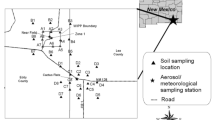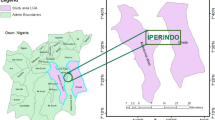Abstract
The aim of the present study was to determine the internal dose in humans after the ingestion of soil highly contaminated with uranium. Therefore, an in vitro solubility assay was performed to estimate the bioaccessibility of uranium for two types of soil. Based on the results, the corresponding bioavailabilities were assessed by using a recently published method. Finally, these bioavailability data were used together with the biokinetic model of uranium to assess the internal doses for a hypothetical but realistic scenario characterized by a daily ingestion of 10 mg of soil over 1 year. The investigated soil samples were from two former uranium mining sites of Germany with 238U concentrations of about 460 and 550 mg/kg. For these soils, the bioavailabilities of 238U were quantified as 0.18 and 0.28 % (geometric mean) with 2.5th percentiles of 0.02 and 0.03 % and 97.5th percentiles of 1.48 and 2.34 %, respectively. The corresponding calculated annual committed effective doses for the assumed scenario were 0.4 and 0.6 µSv (GM) with 2.5th percentiles of 0.2 and 0.3 µSv and 97.5th percentiles of 1.6 and 3.0 µSv, respectively. These annual committed effective doses are similar to those from natural uranium intake by food and drinking water, which is estimated to be 0.5 µSv. Based on the present experimental data and the selected ingestion scenario, the investigated soils—although highly contaminated with uranium—are not expected to pose any major health risk to humans related to radiation.



Similar content being viewed by others
References
Abrahams PW (2002) Soils: their implications to human health. Sci Total Environ 291:1–32
Barrett PHR, Bell BM, Cobelli C, Golde H, Schumitzky A, Vicini P, Foster DM (1998) SAAM II: simulation, analysis, and modeling software for tracer and pharmacokinetic studies. Metabolism 47:484–492
Berglund M, Wieser ME (2011) Isotopic compositions of the elements 2009 (IUPAC technical report). Pure Appl Chem 83:397–410
Bleise A, Danesi PR, Burkart W (2003) Properties, use and health effects of depleted uranium (DU): a general overview. J Environ Radioact 64:93–112
Bolch WE, Eckerman KF, Sgouros G, Thomas SR (2009) MIRD Pamphlet No. 21: a generalized schema for radiopharmaceutical dosimetry—standardization of nomenclature. J Nucl Med 50:477–484
Brugge D, Buchner V (2011) Health effects of uranium: new research findings. Rev Environ Health 26:231–249
Chen J, Lariviere D, Timmins R, Verdecchia K (2011) Estimation of uranium GI absorption fractions for children and adults. Radiat Prot Dosim 144:379–383
DIN (2000) Soil quality—absorption availability of organic and inorganic pollutants from contaminated soil material. DIN E 19738. Deutsches Institut für Normung, Berlin, Germany
Frelon S, Chazel V, Tourlonias E, Blanchardon E, Bouisset P, Pourcelot L, Paquet F (2007) Risk assessment after internal exposure to black sand from Camargue: uptake and prospective dose calculation. Radiat Prot Dosim 127:64–67
Höllriegl V, Li WB, Leopold K, Gerstmann U, Oeh U (2010) Solubility of uranium and thorium from a healing earth in synthetic gut fluids: a case study for use in dose assessments. Sci Total Environ 408:5794–5800
ICRP (1979) Limits for intakes of radionuclides by workers. Part 1. ICRP Publication 30. International commission on radiological protection, Oxford
ICRP (1989) Age-dependent doses to members of the public from intake of radionuclides. Part 1: ingestion dose coefficients. ICRP Publication 56. Pergamon Press, Oxford
ICRP (1991) 1990 Recommendations of the international commission on radiological protection. ICRP Publication 60. Pergamon Press, Oxford
ICRP (1995a) Age-dependent doses to members of the public from intake of radionuclides. Part 3: ingestion dose coefficients. ICRP Publication 69. Pergamon Press, Oxford
ICRP (1995b) Age-dependent doses to members of the public from intake of radionuclides. Part 4: inhalation dose coefficients. ICRP Publication 71. Pergamon Press, Oxford
ICRP (1997) Individual monitoring for internal exposure of workers. ICRP publication 78. Pergamon Press, Oxford
ICRP (2006) Human alimentary tract model for radiological protection. ICRP Publication 100. Elsevier, Oxford
ICRP (2007) The 2007 Recommendations of the international commission on radiological protection. ICRP publication 103. Elsevier, Oxford
ICRP (2008) Nuclear decay data for dosimetric calculations. ICRP publication 107. International Commission of Radiological Protection, Oxford
Jovanovic SV, Pan P, Wong L (2012) Bioaccessibility of uranium in soil samples from Port Hope, Ontario, Canada. Environ Sci Technol 46:9012–9018
Langella F, Grawunder A, Stark R, Weist A, Merten D, Haferburg G, Buchel G, Kothe E (2014) Microbially assisted phytoremediation approaches for two multi-element contaminated sites. Environ Sci Pollut Res Int 21:6845–6858
Mkandawire M (2013) Biogeochemical behaviour and bioremediation of uranium in waters of abandoned mines. Environ Sci Pollut Res Int 20:7740–7767
Schnug E, Lottermoser BG (2013) Fertilizer-derived uranium and its threat to human health. Environ Sci Technol 47:2433–2434
Schramel P, Wolf A, Seif R, Klose BJ (1980) New device for ashing of biological material under pressure. Fresenius Z Anal Chem 302:62–64
Simon SL (1998) Soil ingestion by humans: a review of history, data, and etiology with application to risk assessment of radioactively contaminated soil. Health Phys 74:647–672
Sing D, Sing CF (2010) Impact of direct soil exposures from airborne dust and geophagy on human health. Int J Environ Res Public Health 7:1205–1223
Stanek EJ 3rd, Calabrese EJ, Barnes R, Pekow P (1997) Soil ingestion in adults—results of a second pilot study. Ecotoxicol Environ Saf 36:249–257
Stanek EJ 3rd, Calabrese EJ, Xu B (2012) Meta-analysis of mass-balance studies of soil ingestion in children. Risk Anal 32:433–447
Träber SC, Höllriegl V, Li W, Czeslik U, Rühm W, Oeh U, Michalke M (2014) Estimating the absorption of soil-derived uranium in humans. Environ Sci Technol 48:14721–14727
UNSCEAR (2000) Sources and effects of ionizing radiation. United Nations Scientific Committee on the Effects of Atomic Radiation, New York
UNSCEAR (2008) Sources and effects of ionizing radiation. United Nations Scientific Committee on the Effects of Atomic Radiation, New York
UNSCEAR (2013) Sources, effects and risks of ionizing radiation, annex B—effects of radiation exposure of children. United Nations Scientific Committee on the Effects of Atomic Radiation, New York
WNA (2014) Uranium production figures, 2003–2013. http://www.world-nuclear.org/info/Facts-and-Figures/Uranium-production-figures/. Accessed 15 Mar 2015
Acknowledgments
This work was supported by the German Federal Ministry of Education and Research (BMBF) with the Contract No. 02NUK015B. The contents are solely the responsibility of the authors.
Author information
Authors and Affiliations
Corresponding authors
Rights and permissions
About this article
Cite this article
Träber, S.C., Li, W.B., Höllriegl, V. et al. Calculation of internal dose from ingested soil-derived uranium in humans: Application of a new method. Radiat Environ Biophys 54, 265–272 (2015). https://doi.org/10.1007/s00411-015-0602-9
Received:
Accepted:
Published:
Issue Date:
DOI: https://doi.org/10.1007/s00411-015-0602-9




